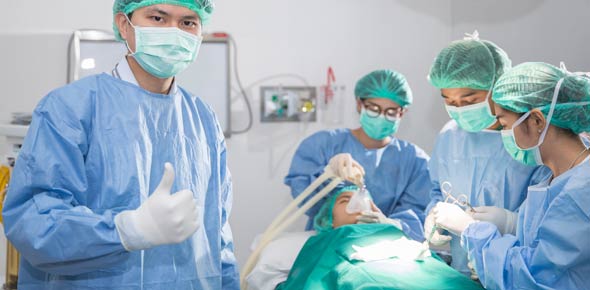Compression of the median nerve at the volar surface of the wrist is...
What procedure is used intraoperatively and postoperatively to...
The term in situ graft represents the use of a (n)
Orthopedic surgery prepping
Joint reconstruction is known as
Which orthopedic hip procedure is indiscted for patients with...
Decreased bone mass results in a condition called
What catheter is used to remove thrombi or emboli from vascular...
Which of the following is used to control bleeding beneath the skull...
A total hip replacement would be indicated when the patient has
A lateral curvature of the spine is
A rotator cuff repair is called a
The ideal candidate for a noncemented total hip arthroplasty is
The technique applied to the patient who is unable to be weaned from...
A fixation device that provides maximum holding and rigid fixation of...
What is the proper wrapping procedure utilizing an Esmarch bandage?
Removal of atherosclerotic plaque from a major artery is termed
Which of the following is a disadvantage of arthroscopic surgery?
An infection in bone is termed
A tumor arising from the covering of the brain is a (n)
The intraoperative endoscopic visualization of internal vessels is...
After surgery on a shoulder, the arm may be bound against the side of...
A drug used intraoperatively for its antispasmodic effect on the...
All of the following are considered good methods of maintaining strict...
What is the treatment of choice for capturing emboli that arise from...
Electrical stimulation is artificially applied postoperative...
During a vascular procedure, monitoring the activated clotting time...
An abnormal localized dilatation of an artery resulting from...
Seamless tubular cotton that stretches to fit a contour and is used...
Harrington rods are used to treat
A dorsal angulated fracture of the distal radius is commonly called a...
An immobilization device used after total hip arthroplasty is
Which fracture most commonly occurs in childhood?
A procedure done to correct recurrent anterior dislocation of the...
In vascular surgery, the term in situ graft references the use of a...
Baker's cysts are found in the
A prosthetic implant that allows gliding and shifting motions...
Surgery on the medial malleolus would be of the
To provide decompression of the spinal roots and vertebral alignment...
In orthopedic surgery, the viewing of the progression of a procedure...
Water temperature for plaster cast application is
Plaster is ready for application
A flexion deformity at the proximal joint of the four lateral toes is...
In a total hip replacement, which structure is reamed?
Which operative procedure facilitates the draining of a subdural...
Limb exsanguination is accomplished by using
What skeletal traction requires the use of sterile supplies for...
The surgery scheduled as "Greenfield filter insertion"...
All of the follwing are frames used to attain the prone position...
Galvanic corrosion is a process that occurs postoperatively because of
A surgical procedure designed to stiffen or fuse a joint is called
Which suture is commonly used to attach tendon to bone?
A low-molecular-weight protein that, when combined with heparin,...
What is the purpose for the surgical creation of an arteriovenous...
An abduction pillow would be used to
The rare use of laser during orthopedic surgery may be seen in the use...
What is the most common acquired valvular lesion?
What drug is used to effect coronary thrombolysis in the cardiac...
An olecranon fracture occurs in the
Conservative treatment of occlusive dissease involving recanalization...
Surgery that requires incision of the long extensor tendon of the...
Compression force of the distal femur upon the tibia produces varying...
Before the insertion of cement into the femoral medullary canal during...
Benign outpouchings of synovium from intercarpal joints are called
To maintain hydrostatic pressure against the joint wall during...
An infectious musculoskeletal condition affecting the bone and marrow...
Which of the following are tongs providing skeletal traction for...
The most commonly fractured carpal bone is the
Place the stages of fracture healing in order: (1) hematoma...
Hemostasis in neurosurgery is achieved by using Gelfoam saturated with...
Orthopedic implants are covered by all of the following rules EXCEPT
Fracture of the patella may be repaired with all of the following...
Reney clips are
A Free Lock compression screw system is indicated for correction of a...
All of the following are intramedullary nails or rods EXCEPT
What drug is used intraoperatively in a topical manner for its direct...
The most commonly used implants in hand surgery are made of flexible
The procedure indicated by which of the following named prostheses...
A large, encapsulated collection of blood over one or both cerebral...
Fracture of the lateral malleolus can be treated with a
The most frequent site of cartilage tears in the knee joint are at the
What intraoperative test determines the needed reversal or addition of...
What is the name of a shoulder positioning device used to position a...
Surgical creation of a lesion in the treatment of a disease such as...
During neurosurgical procedures, venous stasis in the lower...
Compression of subclavian vessels and brachial plexus at the superior...
A variation of bunionectomy, in which the surgeon includes resection...
Osteogenesis or bone growth can be induced by
A surgical procedure in which a nerve is freed from binding adhesion...
Femoral prostheses such as Austin Moore and Thompson are used to...
The congenital deformity known as clubfoot is surgically referred to...
Total wrist replacement indicates use of which of the following...
Which of the following is added to polymethylmethacrylate (PMMA),...
Which total joint arthroplasty utilizes the Miller-Galante joint...
All of the following are indications for external fixation EXCEPT
Before sterilizing unsterile Silastic or Teflon implants, they...
A surgical procedure used most frequently to control intractable pain...
Anterior spinal fusion is accomplished by use of which of the...
Which harware could not be used to repair a tibial plateau fracture?
The proper positioning for a patient under going arthroscopic knee...
















